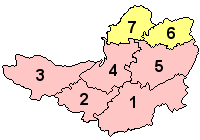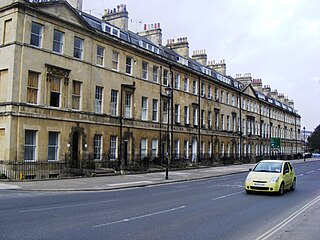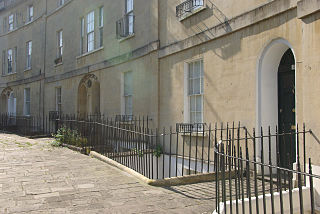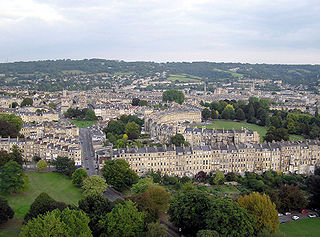| Sion Hill Place | |
|---|---|
Sion Hill Place with Summerhill at the near end | |
| Location | Bath, Somerset, England |
| Coordinates | 51°23′41″N2°22′21″W / 51.39472°N 2.37250°W Coordinates: 51°23′41″N2°22′21″W / 51.39472°N 2.37250°W |
| Built | 1818-1820 |
| Architect | John Pinch the elder [1] |
Listed Building – Grade I | |
| Official name: Summerhill and Numbers 1 to 9 | |
| Designated | 12 June 1950 [2] |
| Reference no. | 443612 |
Sion Hill Place in the Lansdown area of Bath, Somerset, England was designed by John Pinch the elder [1] and built between 1818 and 1820. Suspension bridge builder and brewer James Dredge, Sr. lived here in the mid 19th century.

Lansdown is a suburb of the World Heritage City of Bath, England, that extends northwards from the city centre up a hill of the same name. Among its most distinctive architectural features are Lansdown Crescent and Sion Hill Place, which includes a campus of Bath Spa University.

Bath is the largest city in the ceremonial county of Somerset, England, known for its Roman-built baths. In 2011, the population was 88,859. Bath is in the valley of the River Avon, 97 miles (156 km) west of London and 11 miles (18 km) south-east of Bristol. The city became a World Heritage site in 1987.

Somerset is a county in South West England which borders Gloucestershire and Bristol to the north, Wiltshire to the east, Dorset to the south-east and Devon to the south-west. It is bounded to the north and west by the Severn Estuary and the Bristol Channel, its coastline facing southeastern Wales. Its traditional border with Gloucestershire is the River Avon. Somerset's county town is Taunton.
Summerhill and numbers 1 to 9 have been designated as a Grade I listed building. [2]

A listed building, or listed structure, is one that has been placed on one of the four statutory lists maintained by Historic England in England, Historic Environment Scotland in Scotland, Cadw in Wales, and the Northern Ireland Environment Agency in Northern Ireland.
The Georgian terrace of numbers 1 to 9 is made up of 4 storey houses which is symmetrical from which the centre house, number 5, stands forward and has a pediment. The ground floor of all houses is rusticated. The houses at either end have curved segmental bows for their entire height. [2] Numbers 1 to 4 were built by William Cowell Hayes a local painter, while Daniel Aust, from Walcot, built number 5 and possibly the others. [3]

Georgian architecture is the name given in most English-speaking countries to the set of architectural styles current between 1714 and 1830. It is eponymous for the first four British monarchs of the House of Hanover—George I, George II, George III, and George IV—who reigned in continuous succession from August 1714 to June 1830. The style was revived in the late 19th century in the United States as Colonial Revival architecture and in the early 20th century in Great Britain as Neo-Georgian architecture; in both it is also called Georgian Revival architecture. In the United States the term "Georgian" is generally used to describe all buildings from the period, regardless of style; in Britain it is generally restricted to buildings that are "architectural in intention", and have stylistic characteristics that are typical of the period, though that covers a wide range.

A pediment is an architectural element found particularly in classical, neoclassical and baroque architecture, and its derivatives, consisting of a gable, usually of a triangular shape, placed above the horizontal structure of the entablature, typically supported by columns. The tympanum, the triangular area within the pediment, is often decorated with relief sculpture.

In classical architecture rustication is a range of masonry techniques giving visible surfaces a finish that contrasts in texture with the smoothly finished, squared-block masonry surfaces called ashlar. The visible face of each individual block is cut back around the edges to make its size and placing very clear. In addition the central part of the face of each block may be given a deliberately rough or patterned surface.
Summerhill House, which is attached to the west end of the terrace, came from Chippenham and was demolished and transported stone by stone. [2]

Chippenham is a large historic market town in northwest Wiltshire, England. It lies 20 miles (32 km) east of Bristol, 86 miles (138 km) west of London and 4 miles (6 km) west of The Cotswolds AONB. The town was established on a crossing of the River Avon and some form of settlement is believed to have existed there since before Roman times. It was a royal vill, and probably a royal hunting lodge, under Alfred the Great. The town continued to grow when the Great Western Railway arrived in 1841; it is now a major commuter town.
Famous Residents
Madame Sarah Grand, Writer, Suffragist, and sometime Lady Mayoress of Bath (alongside Mayor Cedric Chivers) lived at number 7 from c1926-1942/3. [4]

Sarah Grand was an Irish feminist writer active from 1873 to 1922. Her work revolved around the New Woman ideal.



















